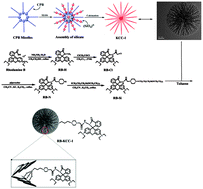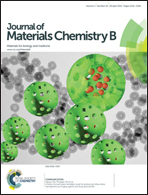Multifunctional fibrous silica composite with high optical sensing performance and effective removal ability toward Hg2+ ions†
Abstract
A multifunctional organic–inorganic hybrid sensing material (RB-KCC-1) was prepared by the immobilization of a rhodamine-based receptor (RB-Si) within the channels of fibrous silica spheres (KCC-1), and characterized by transmission electron microscopy, scanning electron microscopy, Fourier transform infrared spectroscopy, N2 adsorption–desorption, and UV-vis absorption and fluorescence spectroscopy. This multifunctional sensor exhibits high surface area, large open pores and a flexible fibrous structure, and excellent optical sensing properties that allow for highly selective, sensitive and “naked eye” Hg2+ detection. The fluorescence enhancement responses of RB-KCC-1 are associated with the spirolactam ring opening of the rhodamine group, and a detection limit of 9.05 × 10−7 M is obtained. In additional, it is also an excellent adsorbent for the removal of Hg2+ from aqueous solution. The adsorption process of Hg2+ on RB-KCC-1 is well described by the Langmuir isotherm equation, and the equilibrium adsorption capacity is 115.47 mg g−1. These results indicate that these multifunctional composites may have good potential as favorable materials for the facile detection and effective removal of Hg2+ in biological, environmental, and industrial fields.


 Please wait while we load your content...
Please wait while we load your content...